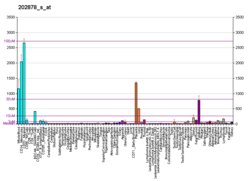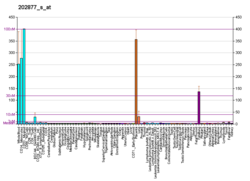| CD93 | |||||||||||||||||||||||||||||||||||||||||||||||||||
|---|---|---|---|---|---|---|---|---|---|---|---|---|---|---|---|---|---|---|---|---|---|---|---|---|---|---|---|---|---|---|---|---|---|---|---|---|---|---|---|---|---|---|---|---|---|---|---|---|---|---|---|
| Identifiers | |||||||||||||||||||||||||||||||||||||||||||||||||||
| Aliases | CD93, C1QR1, C1qR(P), C1qRP, CDw93, ECSM3, MXRA4, dJ737E23.1, CD93 molecule | ||||||||||||||||||||||||||||||||||||||||||||||||||
| External IDs | OMIM: 120577 MGI: 106664 HomoloGene: 7823 GeneCards: CD93 | ||||||||||||||||||||||||||||||||||||||||||||||||||
| |||||||||||||||||||||||||||||||||||||||||||||||||||
| |||||||||||||||||||||||||||||||||||||||||||||||||||
| |||||||||||||||||||||||||||||||||||||||||||||||||||
| |||||||||||||||||||||||||||||||||||||||||||||||||||
| |||||||||||||||||||||||||||||||||||||||||||||||||||
| Wikidata | |||||||||||||||||||||||||||||||||||||||||||||||||||
| |||||||||||||||||||||||||||||||||||||||||||||||||||
CD93 (Cluster of Differentiation 93) is a protein that in humans is encoded by the CD93 gene.[5][6][7] CD93 is a C-type lectin transmembrane receptor which plays a role not only in cell–cell adhesion processes but also in host defense.[7]
Family[edit]
CD93 belongs to the Group XIV C-Type lectin family,[8] a group containing three other members, endosialin (CD248), CLEC14A[9] and thrombomodulin, a well characterized anticoagulant. All of them contain a C-type lectin domain, a series of epidermal growth factor like domains, a highly glycosylated mucin-like domain, a unique transmembrane domain and a short cytoplasmic tail. Due to their strong homology and their close proximity on chromosome 20, CD93 has been suggested to have arisen from the thrombomodulin gene through a duplication event.
Expression[edit]
CD93 was originally identified in mice as an early B cell marker through the use of AA4.1 monoclonal antibody.[10][11] Then this molecule was shown to be expressed on an early population of hematopoietic stem cells, which give rise to the entire spectrum of mature cells in the blood. Now CD93 is known to be expressed by a wide variety of cells such as platelets, monocytes, microglia and endothelial cells. In the immune system CD93 is also expressed on neutrophils, activated macrophages, B cell precursors until the T2 stage in the spleen, a subset of dendritic cells and of natural killer cells. Molecular characterization of CD93 revealed that this protein is identical with C1qRp, a human protein identified as a putative C1q receptor.[12] C1q belongs to the complement activation proteins and plays a major role in the activation of the classical pathway of the complement, which leads to the formation of the membrane attack complex. C1q is also involved in other immunological processes such as enhancement of bacterial phagocytosis, clearance of apoptotic cells or neutralisation of virus. Strikingly, it has been shown that anti-C1qRp significantly reduced C1q enhanced phagocytosis. A more recent study confirmed that C1qRp is identical to CD93 protein, but failed to demonstrate a direct interaction between CD93 and C1q under physiological conditions. Recently it has been shown that CD93 is re-expressed during the late B cell differentiation and CD93 can be used in this context as a plasma cell maturation marker. CD93 has been found to be differentially expressed in grade IV glioma vasculature when compared to low grade glioma or normal brain and its high expression correlated with the poor survival of the patients.[13][14]
Function[edit]
CD93 was initially thought to be a receptor for C1q, but now is thought to instead be involved in intercellular adhesion and in the clearance of apoptotic cells. The intracellular cytoplasmic tail of this protein contains two highly conserved domains which may be involved in CD93 function. Indeed, the highly charged juxtamembrane domain has been found to interact with moesin, a protein known to play a role in linking transmembrane proteins to the cytoskeleton and in the remodelling of the cytoskeleton. This process appears crucial for both adhesion, migration and phagocytosis, three functions in which CD93 may be involved.
In the context of late B cell differentiation, CD93 has been shown to be important for the maintenance of high antibody titres after immunization and in the survival of long-lived plasma cells in the bone marrow. Indeed, CD93 deficient mice failed to maintain high antibody level upon immunization and present a lower amount of antigen specific plasma cells in the bone marrow.
In the context of the endothelial cells, CD93 is involved in endothelial cell-cell adhesion, cell spreading, cell migration, cell polarization as well as tubular morphogenesis.[14] Recently it has been found that CD93 is able to control endothelial cell dynamics through its interaction with an extracellular matrix glycoprotein MMRN2.[15] Absence of CD93 or its interacting partner MMRN2 in the endothelial cells lead to disruption of extracellular matrix protein fibronectin fibrillogenesis and decreased integrin B1 activation.[15]
CD93 plays a significant role in the glioma development. CD93 knockout mice with glioma show smaller tumor size and improved survival.[14] The tumors also show disrupted fibronectin fibrillogenesis and decreased integrin B1 activation.[15]
See also[edit]
References[edit]
- ^ a b c GRCh38: Ensembl release 89: ENSG00000125810 – Ensembl, May 2017
- ^ a b c GRCm38: Ensembl release 89: ENSMUSG00000027435 – Ensembl, May 2017
- ^ "Human PubMed Reference:". National Center for Biotechnology Information, U.S. National Library of Medicine.
- ^ "Mouse PubMed Reference:". National Center for Biotechnology Information, U.S. National Library of Medicine.
- ^ Nepomuceno RR, Henschen-Edman AH, Burgess WH, Tenner AJ (February 1997). "cDNA cloning and primary structure analysis of C1qR(P), the human C1q/MBL/SPA receptor that mediates enhanced phagocytosis in vitro". Immunity. 6 (2): 119–29. doi:10.1016/S1074-7613(00)80419-7. PMID 9047234.
- ^ Webster SD, Park M, Fonseca MI, Tenner AJ (January 2000). "Structural and functional evidence for microglial expression of C1qR(P), the C1q receptor that enhances phagocytosis". Journal of Leukocyte Biology. 67 (1): 109–16. doi:10.1002/jlb.67.1.109. PMID 10648005. S2CID 14982216.
- ^ a b "Entrez Gene: CD93 CD93 molecule".
- ^ Khan KA, McMurray J, Mohammed FM, Bicknell R (2019). "C-type lectin domain group 14 proteins in vascular biology, cancer and inflammation". FEBS Journal. 286 (17): 3299–3332. doi:10.1111/febs.14985. PMC 6852297. PMID 31287944.
- ^ Mura M, Swain RK, Zhuang X, Vorschmitt H, Reynolds G, Durant S, Beesley JF, Herbert JM, Sheldon H, Andre M, Sanderson S, Glen K, Luu NT, McGettrick HM, Antczak P, Falciani F, Nash GB, Nagy ZS, Bicknell R (January 2012). "Identification and angiogenic role of the novel tumor endothelial marker CLEC14A". Oncogene. 31 (3): 293–305. doi:10.1038/onc.2011.233. PMID 21706054.
- ^ McKearn JP, Baum C, Davie JM (January 1984). "Cell surface antigens expressed by subsets of pre-B cells and B cells". Journal of Immunology. 132 (1): 332–9. doi:10.4049/jimmunol.132.1.332. PMID 6606670. S2CID 27256762.
- ^ Zekavat G, Mozaffari R, Arias VJ, Rostami SY, Badkerhanian A, Tenner AJ, Nichols KE, Naji A, Noorchashm H (June 2010). "A novel CD93 polymorphism in non-obese diabetic (NOD) and NZB/W F1 mice is linked to a CD4+ iNKT cell deficient state". Immunogenetics. 62 (6): 397–407. doi:10.1007/s00251-010-0442-3. PMC 2875467. PMID 20387063.
- ^ McGreal EP, Ikewaki N, Akatsu H, Morgan BP, Gasque P (May 2002). "Human C1qRp is identical with CD93 and the mNI-11 antigen but does not bind C1q". Journal of Immunology. 168 (10): 5222–32. doi:10.4049/jimmunol.168.10.5222. PMID 11994479.
- ^ Dieterich LC, Mellberg S, Langenkamp E, Zhang L, Zieba A, Salomäki H, Teichert M, Huang H, Edqvist PH, Kraus T, Augustin HG, Olofsson T, Larsson E, Söderberg O, Molema G, Pontén F, Georgii-Hemming P, Alafuzoff I, Dimberg A (November 2012). "Transcriptional profiling of human glioblastoma vessels indicates a key role of VEGF-A and TGFβ2 in vascular abnormalization". The Journal of Pathology. 228 (3): 378–90. doi:10.1002/path.4072. PMID 22786655. S2CID 31223309.
- ^ a b c Langenkamp E, Zhang L, Lugano R, Huang H, Elhassan TE, Georganaki M, Bazzar W, Lööf J, Trendelenburg G, Essand M, Pontén F, Smits A, Dimberg A (November 2015). "Elevated expression of the C-type lectin CD93 in the glioblastoma vasculature regulates cytoskeletal rearrangements that enhance vessel function and reduce host survival". Cancer Research. 75 (21): 4504–16. doi:10.1158/0008-5472.CAN-14-3636. PMID 26363010.
- ^ a b c Lugano R, Vemuri K, Yu D, Bergqvist M, Smits A, Essand M, Johansson S, Dejana E, Dimberg A (August 2018). "CD93 promotes β1 integrin activation and fibronectin fibrillogenesis during tumor angiogenesis". The Journal of Clinical Investigation. 128 (8): 3280–3297. doi:10.1172/JCI97459. PMC 6063507. PMID 29763414.
Further reading[edit]
- Chevrier S, Genton C, Kallies A, Karnowski A, Otten LA, Malissen B, Malissen M, Botto M, Corcoran LM, Nutt SL, Acha-Orbea H (March 2009). "CD93 is required for maintenance of antibody secretion and persistence of plasma cells in the bone marrow niche". Proceedings of the National Academy of Sciences of the United States of America. 106 (10): 3895–900. Bibcode:2009PNAS..106.3895C. doi:10.1073/pnas.0809736106. PMC 2656176. PMID 19228948.
- Tenner AJ (August 1998). "C1q receptors: regulating specific functions of phagocytic cells". Immunobiology. 199 (2): 250–64. doi:10.1016/s0171-2985(98)80031-4. PMID 9777410.
- Ghebrehiwet B, Peerschke EI, Hong Y, Munoz P, Gorevic PD (June 1992). "Short amino acid sequences derived from C1q receptor (C1q-R) show homology with the alpha chains of fibronectin and vitronectin receptors and collagen type IV". Journal of Leukocyte Biology. 51 (6): 546–56. doi:10.1002/jlb.51.6.546. PMID 1377218. S2CID 1214598.
- Peerschke EI, Ghebrehiwet B (November 1990). "Platelet C1q receptor interactions with collagen- and C1q-coated surfaces". Journal of Immunology. 145 (9): 2984–8. doi:10.4049/jimmunol.145.9.2984. PMID 2212670. S2CID 25469682.
- Eggleton P, Lieu TS, Zappi EG, Sastry K, Coburn J, Zaner KS, Sontheimer RD, Capra JD, Ghebrehiwet B, Tauber AI (September 1994). "Calreticulin is released from activated neutrophils and binds to C1q and mannan-binding protein". Clinical Immunology and Immunopathology. 72 (3): 405–9. doi:10.1006/clin.1994.1160. PMID 8062452.
- Joseph K, Ghebrehiwet B, Peerschke EI, Reid KB, Kaplan AP (August 1996). "Identification of the zinc-dependent endothelial cell binding protein for high molecular weight kininogen and factor XII: identity with the receptor that binds to the globular "heads" of C1q (gC1q-R)". Proceedings of the National Academy of Sciences of the United States of America. 93 (16): 8552–7. Bibcode:1996PNAS...93.8552J. doi:10.1073/pnas.93.16.8552. PMC 38710. PMID 8710908.
- Cáceres J, Brandan E (May 1997). "Interaction between Alzheimer's disease beta A4 precursor protein (APP) and the extracellular matrix: evidence for the participation of heparan sulfate proteoglycans". Journal of Cellular Biochemistry. 65 (2): 145–58. doi:10.1002/(SICI)1097-4644(199705)65:2<145::AID-JCB2>3.0.CO;2-U. PMID 9136074. S2CID 43911847.
- Nepomuceno RR, Tenner AJ (February 1998). "C1qRP, the C1q receptor that enhances phagocytosis, is detected specifically in human cells of myeloid lineage, endothelial cells, and platelets". Journal of Immunology. 160 (4): 1929–35. doi:10.4049/jimmunol.160.4.1929. PMID 9469455. S2CID 25486549.
- Stuart GR, Lynch NJ, Day AJ, Schwaeble WJ, Sim RB (December 1997). "The C1q and collectin binding site within C1q receptor (cell surface calreticulin)". Immunopharmacology. 38 (1–2): 73–80. doi:10.1016/S0162-3109(97)00076-3. PMID 9476117.
- Nepomuceno RR, Ruiz S, Park M, Tenner AJ (March 1999). "C1qRP is a heavily O-glycosylated cell surface protein involved in the regulation of phagocytic activity". Journal of Immunology. 162 (6): 3583–9. doi:10.4049/jimmunol.162.6.3583. PMID 10092817. S2CID 22415546.
- Norsworthy PJ, Taylor PR, Walport MJ, Botto M (August 1999). "Cloning of the mouse homolog of the 126-kDa human C1q/MBL/SP-A receptor, C1qR(p)". Mammalian Genome. 10 (8): 789–93. doi:10.1007/s003359901093. PMID 10430665. S2CID 2160211.
- Hartley JL, Temple GF, Brasch MA (November 2000). "DNA cloning using in vitro site-specific recombination". Genome Research. 10 (11): 1788–95. doi:10.1101/gr.143000. PMC 310948. PMID 11076863.
- Kittlesen DJ, Chianese-Bullock KA, Yao ZQ, Braciale TJ, Hahn YS (November 2000). "Interaction between complement receptor gC1qR and hepatitis C virus core protein inhibits T-lymphocyte proliferation". The Journal of Clinical Investigation. 106 (10): 1239–49. doi:10.1172/JCI10323. PMC 381434. PMID 11086025.
- Joseph K, Shibayama Y, Ghebrehiwet B, Kaplan AP (January 2001). "Factor XII-dependent contact activation on endothelial cells and binding proteins gC1qR and cytokeratin 1". Thrombosis and Haemostasis. 85 (1): 119–24. doi:10.1055/s-0037-1612914. PMID 11204562. S2CID 35432595.
- Simpson JC, Wellenreuther R, Poustka A, Pepperkok R, Wiemann S (September 2000). "Systematic subcellular localization of novel proteins identified by large-scale cDNA sequencing". EMBO Reports. 1 (3): 287–92. doi:10.1093/embo-reports/kvd058. PMC 1083732. PMID 11256614.
- Steinberger P, Szekeres A, Wille S, Stöckl J, Selenko N, Prager E, Staffler G, Madic O, Stockinger H, Knapp W (January 2002). "Identification of human CD93 as the phagocytic C1q receptor (C1qRp) by expression cloning". Journal of Leukocyte Biology. 71 (1): 133–40. doi:10.1189/jlb.71.1.133. PMID 11781389. S2CID 31767877.
External links[edit]
- CD93+protein,+human at the U.S. National Library of Medicine Medical Subject Headings (MeSH)
- Human CD93 genome location and CD93 gene details page in the UCSC Genome Browser.





